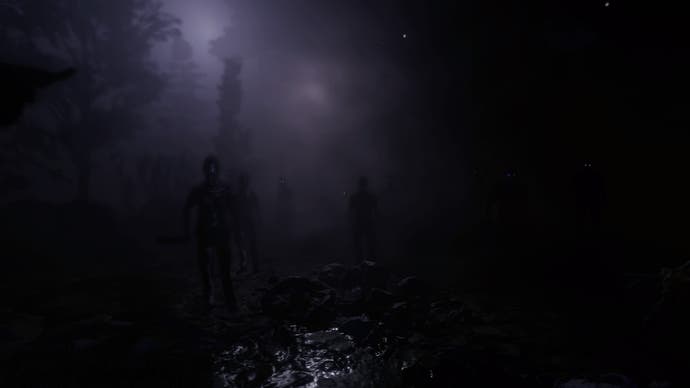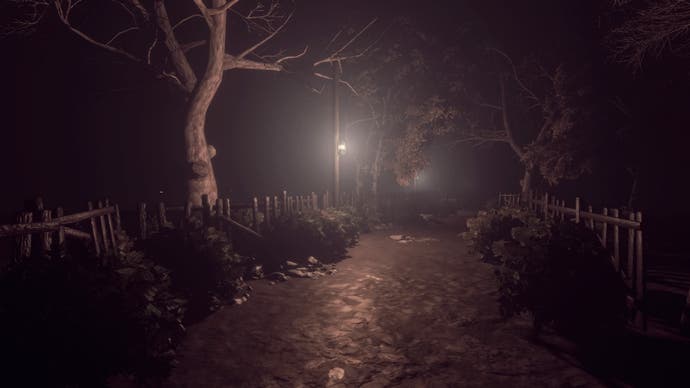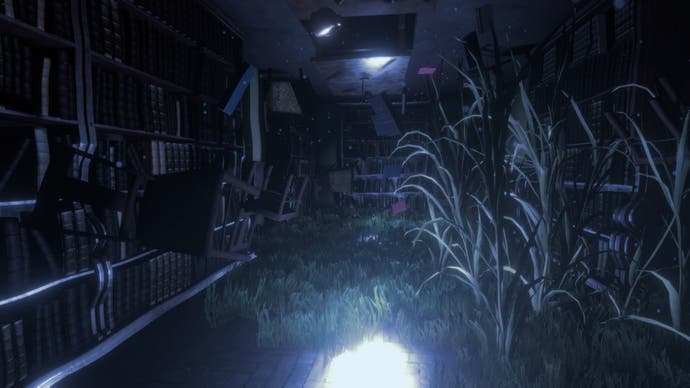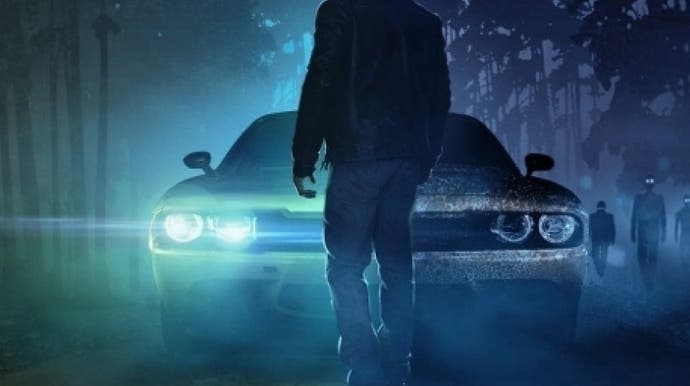Those Who Remain review - a torturous exercise in mediocrity
Left behind.
I almost gave up on Those Who Remain halfway through. It was the lions, you see. A first-person blunderfest for horror obsessives only, the game's setting is split between a menacing night-time reality and a weed-choked, oceanic otherworld in which objects float and the puzzles are more, well, videogamey. One such puzzle is a labyrinth dotted with lion statues. The idea is to carry the statues to candlelit plinths. The problem is that there's a monster in your path, an oily personification of buried guilt and suffering. There's a lot of that kind of thing in Those Who Remain - accusing messages on walls, silver-masked demons chortling about sin and forgiveness - but for the most part, the emotions you're repressing are boredom and frustration.
The main character has no means of defending himself, so you must take winding routes to those plinths while lugging chunks of Umbrella Mansion Surplus stoneware that prevent you from sprinting, block the view and have a habit of jumping out of your hands. These burdens create tension, of course, but only for the few seconds it takes you to realise that you're playing a mandatory-stealth McGuffin-fetching puzzle with instadeath. After my eighth try I decided that life was too short. But I came back the next morning and beat the area, thanks partly to bloody-mindedness and partly (I speculate) to a developer update that prevents the monster from chasing you endlessly once alerted. Let me tell you: I wish I'd stopped at the lions.

Those Who Remain does have some neat ideas, but all of them are squashed beneath a great steaming heap of mediocrity. The premise is Silent Hill as rewritten by an Alan Wake who has run out of coffee, and possibly self-respect. Leading man Edward is drinking and monologuing himself into an early grave over the loss of his family, as leading men in horror games often do. As the curtain goes up, he's driven to a motel to break off a torrid affair, only for somebody (Wake?) to steal his car and maroon him outside Dormont - a spookily abandoned, predictably metaphysical town whose shadows are filled with knife-wielding spectres, their eyes flickering in the depths of closets and cornfields. Turn on a light and the spectres vanish, rendering the area safe for traversal.
The immediate question is: why not carry a light source with you? And Edward does - for the first few minutes, brandishing a cigarette lighter as he hurries after his car. But he soon loses the lighter and declines to replace it, even as the game's tedious psychodrama drags you to malls, toolsheds and police stations filled with, at the very least, burning chair-legs and candles. There's something loveable about this unwillingness to spoil the game's core concept. It fills me with nostalgia for those perversely specific lock-and-key puzzles in older Silent Hills. And the spectres are eerie enough to begin with, especially when encountered inside. One dependable source of heeby-jeebies is reaching around a door frame to flip a light switch, inches from death.
The fear lies partly with how the spectres turn Those Who Remain's shortage of actual character animations into an advantage, and partly with the sense that they are still there when the lights are on - that you are walking through them, kept from their blades by a single parameter in a game where objects occasionally glitch themselves invisible. But that fear soon turns to familiarity and - when you're scratching your head over an obtuse item puzzle - annoyance. I started throwing things at the watchers, trying to recreate the exploit from Skyrim where you could blind shopkeepers to your thievery by putting baskets over their heads. Even disregarding the point about mobile light sources, the perils of darkness are inconsistently applied: there are pools of deep shadow in the game that are somehow safe to walk through, which means that you always think of the light/dark conceit as a designer's gimmick.

Still, all that's small potatoes next to the irritation conjured by the game's handful of mobile threats. These include a Frankensteiny blur of body parts with a searchlight for a face, whose approach is heralded by the dopplering wail of an ambulance siren. The Frankenstein creature stars in many of the stealth bits, fidgeting around as you try to solve puzzles that take you back and forth across the area. She's not difficult to avoid, but she's more of a meddler than an adversary. You kind of wish you could just usher her to a chair and give her a book to read, while you figure things out.
And then there's the major antagonist of sorts, one of those flapping-head harridans familiar from Jacob's Ladder who screams and sobs in your ear as you flee down corridors packed with dead ends and moving obstacles. These gauntlet runs throw the game's lousy checkpointing into sharper relief - die, and you'll often have to re-complete puzzles and re-experience scares that were pretty unconvincing to begin with.
The areas themselves are charmless and indistinct, not in an exciting, feeling-along-wall-with-danger-nearby way, but in an annoying, stepped-in-dogfood-while-fumbling-for-the-doorhandle way. The game's buildings are, in theory, iconic chunks of Americana, the kind of thing Remedy revels in, but they all feel interchangeable thanks to furniture-showroom scene composition. The spirit realm is appealing mostly because it's relatively well-lit, and has a wider colour palette. It's accessed via magic doors, and creates some fleeting intrigue as you ponder what the differences between realities suggests about the characters and premise.

The puzzles run more of a gamut, quality-wise. Some are inoffensive but insipid, such as turning valves in the right order to activate fire sprinklers and clear a route. Others are slightly more involving. In one later section, the setting flicks rhythmically between realities, giving you a window to hurry past barriers or hazards that don't exist in the other world. The spirit world conundrums incline towards the goofy - there's a frightfully unwieldy specimen that has you covering runes with barrels to move blocks around. And some puzzles, like the item hunts, are an absolute chore. At intervals Edward is required to condemn or forgive some local sinner to progress, a series of choices that shapes his own fate. Before you can do this you need to learn everything you can about said unfortunate, which involves picking through dozens of lockers and drawers for backstory documents, often while hiding from Searchlight Lady.
Those Who Remain hints at being a serious exploration of mental illness, but in practice, Edward is just the same old Sad/Mad Dad the horror genre can't seem to wash its hands of, growling things like "your life feels like a movie" as he lumbers towards the final accounting. The misbehaving men and boys he's asked to pass judgement on are just as clumsily sketched - I felt nothing towards them, positive or negative. I can't say the same for the game they're a part of. If Those Who Remain is a purgatory for wayward souls, its true victim is the player.


